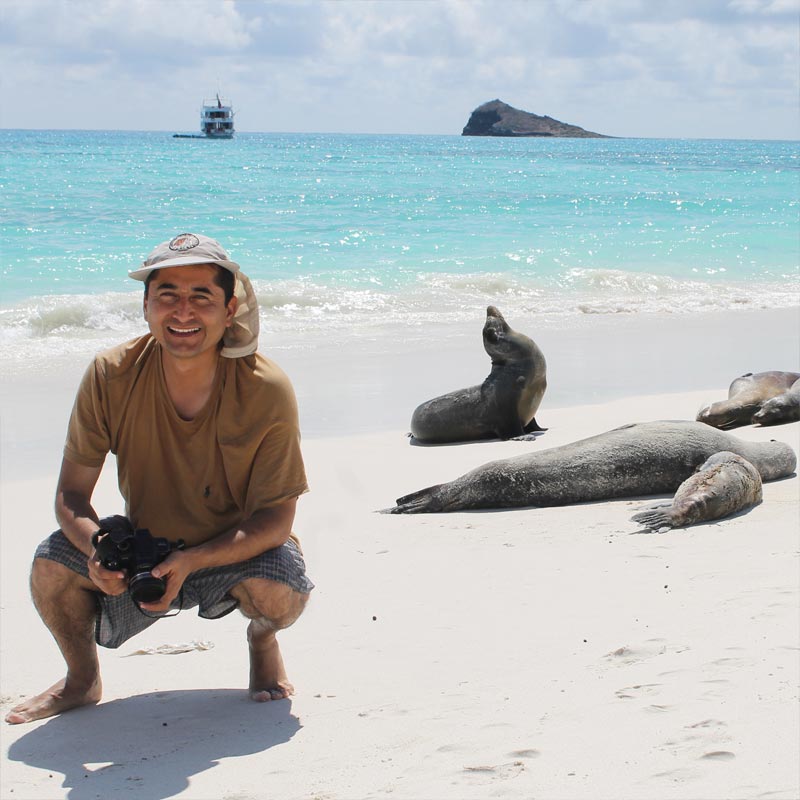THE GALAPAGOS ALBATROSS

SOLEQMASTER
The waved albatross, also known as the Galapagos albatross, is the only member if the Diomedeidae which is located in the tropical regions.
Description
These albatrosses are medium sized, measuring 80 to 90 centimeters in length and a possible wingspan of 220 to 250 centimeters. In terms of weight they range between 2.7 and 4.0 kg, whereas males are significantly heavier than the females.
It is easy to distinct them from other birds due to their yellowish-cream neck and head which significantly contrasts to their rather brownish bodies. Another striking characteristic is their very long bill which is colored in bright yellow and looks rather disproportionate in comparison to their small head and long neck. Finally, and that is probably the most striking characteristic are their blue feet. Furthermore, they are probably one of the birds with the longest life span of 40 to 45 years.
Location
The majority of waved albatrosses breed on Española Island which is part of the Galapagos Archipelago. Española Island is located in the south of the Galapagos archipelago, the English name is Hook and its visitor sites are Punta Suarez and Gardner Bay. Nevertheless, there have been sightings of small numbers of waved albatrosses breeding on Genovesa Island as well as Isla de la Plata. During non-breeding seasons they are shifting towards east and southeast.
Behavior
As most of the coastal birds, the waved albatrosses’ food consists mainly of fish, squid and crustaceans. In addition to that, they also eat smaller birds and have been observed to scavenge food from other birds. Moreover, they have a range of 10 to 100 kilometers to find food for their chicks.
During breeding season, the bird’s nests are built on areas consisting of lava with boulders and sparse vegetation. Breeding season starts in April and goes on until June. After the eggs have been laid, they have to be incubated for another two months. After hatching, the chicks will stay together in small nurseries built buy the adult birds. While in the nursery, the parents fly out to the ocean to find food. In December or January the chicks have reached adult size they leave the colony.
Flight
Known for being spectacular flyers, they can fly for hours without stalling. The waved albatross uses the high wind speed in an altitude of around 15 meters for dynamic soaring which means that they repeatedly cross the boundaries between air masses which provide them with velocity. The bird’s do, however, experience difficulties landing due to their high stalling speed. The same goes from taking off. Due to their massive wings they often use cliffs to easier take off.
SOLEQ.travel organizes splendid tours all around the archipelago such as Island Hopping or Galapagos Cruises.
Also, read about some general information about Galapagos and the Galapagos experience with kids.
https://www.goway.com/media/uploads/pdfs/calendar-for-galapagos-islands.pdf
https://es.wikipedia.org/wiki/Phoebastria_irrorataFoto
https://es.wikipedia.org/wiki/Phoebastria_irrorata
{{subst:Aviso referencias|Phoebastria irrorata}}
visit our other channels
Recent Posts
- Travel Tip Peru – Trujillo March 21, 2025
- Galapagos Travel: Everything You Need to Know for Your Trip March 7, 2025
- Travel Tip Peru – Machu Picchu February 21, 2025
- Travel Tip Peru – Valle Sagrado – The Sacred Valley February 7, 2025
- Travel tip Peru – Lima January 24, 2025